

Go on, why not sponsor this page for $5.00 and have your own message appear in this space. Click here for details. |
Red Dugan
Date and Place of Birth: February 13, 1913 Kansas
Died: July 5, 1992 Hiawatha, Kansas
Baseball Experience:
College
Position: Pitcher
Rank: Sergeant
Military Unit: USAAF
Area Served: United States
At the age of
20, Red married Vera Zirger. She became acting director of Brown County Social
Welfare. They had one daughter, Mary Beth Dugan, who was born in 1952.
With military
service looming, Phog Allen, wrote Commander T J Hamilton at the Navy Department
in Washington, DC, in November, 1942, recommending Dugan for service in helping
in physical fitness in the Navy. “I recommend Ralph Dugan without reservation or
evasion,” wrote Allen. “He is, in my opinion, highly qualified for this type of
work and will do a good job in whatever he undertakes. His character and habits
are of the highest quality. He is a hard worker, thoroughly dependable and
reliable, and uses his head in getting the job done.”
However, Dugan
didn’t take up a position with the Navy, he served, instead, with the Army Air
Corps at Basic Training Center No. 4 in Miami Beach, Florida, where he played football
and pitched. Then, in
1943, he was assigned to Las Vegas Army Air Field and coached the Horned Toads
baseball team for the next three seasons.
Las Vegas Army Air Field
(LVAAF) was eight miles northeast of Las Vegas and was the town’s local airport
before the war. Las Vegas, at that time, was not the place it is today. In 1940, Las Vegas had a population of just 8,422, thanks mainly to the building of the Boulder Dam. It was not the casino rich tourist trap we see today, although it did have two hotels on the highway and traditional gambling spots in the bars and small hotels clustered around the railroad station, which served the entertainment needs of servicemen during the war.
The airport was taken over
by the Eastern Training Flying Command in December 1941, as a training field for
aerial gunners, the first of its kind in the United States. But one thing the
Army Air Force insisted on was that the large and legal red light district be
shut down for the duration of the war. By 1944, LVAAF was training gunners at a
rate of 25,000 a year. Along with Basic Magnesium Inc, in nearby Henderson
bringing thousands of war workers to the area, it is safe to say that Las Vegas
made the most dramatic change of any city in the nation during WWII and by 1950
it could claim a population of over 28,000.
During basic
training it was found that Dugan had warts on his feet. He wanted desperately to
have them removed while in the military. Unfortunately, it took a while before
the surgery was approved since it was believed he came to the military with this
condition. When surgery was completed, he ended up with an infection that
nearly took his legs. He walked with a limp the rest of his life, and the scars
on his feet kept him from active duty. He was able to stay in the military,
however, and to continue the coaching and physical training of troops at Las
Vegas.
The Horned
Toads were one of the strongest baseball teams in Nevada during World War II.
Coached by Lieutenant Robert E Murray of Santa Barbara State College and led on
the field by Ernie Wade of the Philadelphia Athletics and Alex Oshkello, a
catcher in the New York Giants’ organization, the Horned Toads’
1943 season included victories over the
Albuquerque Flying Kellys; Williams Field of Phoenix, Arizona; Wendover Field of
Utah; and Victorville Army Air Field of California.
On July 25, 1942, the
Horned Toads faced Reno Baseball Club for the state semi-pro baseball
championship at Idlewild Park (a softball field converted for baseball) in Reno.
At stakes for the game was a trophy presented by the National Semi-Pro Baseball
Congress, $150 donated by Harold’s Club of Reno, 60 per cent of the money
collected by passing a hat through the stands (there was no admission fee), and
the right to compete in the national semi-pro tournament in Wichita in August.
Reno Baseball Club were the
defending champions and 3,000 fans bulged the bleachers and lined the field for
a record crowd at Idlewild, only to see the local boys beaten, 7 to 1, by the
Horned Toads on the three-hit pitching of Ernie Wade, and four hits (including
two doubles) by right fielder Johnny Arden.
For the semi-pro finals,
the Horned Toads made the journey to Wichita, Kansas by plane. But their winning
streak soon came to an end as they were beaten, 7-1, by the 326th
Glider Squadron from Alliance, Nebraska, on August 17 and then eliminated in a
10-2 rout by the Fort Riley Centaurs the following day.
1943 Las Vegas Army Air
Field Horned Toads Roster
Name
Position
Previous
baseball experience
Lt Norman B Forster
athletic director
Lt Robert E Murray
outfield-coach
(Santa Barbara
State College)
Sgt Red Dugan
coach
Sgt Ray Woodrum
pitcher
Sgt Alex Oshkello
catcher
(property of New
York Giants)
T/Sgt Leon “Red”
Skidgel
first base
(Knoxville of
Southern Association)
Sgt Albert Gallo
second base
(House of David and
Tigers’ organization)
Sgt Joe Wojcicki
third base
(Michigan State
College)
Cpl Charles A Tyler
shortstop
Cpl Robert St
Pierre
leftfield
(Colby College)
T/Sgt Frank Rippee
centerfield
Sgt Lester Wagaman
rightfield
(Earned Purple
Heart at Pearl Harbor)
Pvt Julian Labadie
pitcher
(San Francisco
Seals)
Pvt Ernest Wade
pitcher
(Philadelphia
Athletics)
PFC Willis Shafer
outfield
Pvt Roland Meres
pitcher
(semi-pro from New
York who could pitch with both hands)
Pvt Donald Stein
infield
Pvt Claire
Stenglein
infield
(Ohio State
College)
Johnny Arden
catcher-outfield
(played for Reno in
the Sierra-Nevada League)
Warren Soetever
unknown
Eugene Kuhner
unknown
(Muskogee of
Western Association)
1944 witnessed a major
change in personnel at LVAAF. Lieutenant Robert Murray transferred to Indians
Springs as athletic director. Leon Skidgell, Joe Wojcicki and Charles Tyler also
transferred to Indian Springs Army Air Field. Johnny Arden joined the Reno
Baseball Club for 1944.
Early season victories over
Indian Springs AAF Indians, Tonopah AAF Gunners, Victorville AAF and the Las
Vegas town team, showed the team were still competitors and secured a birth in
the state semi-pro tournament.
In 1943, the state semi-pro
championship had been decided by a single game between the Horned Toads and Reno
Baseball Club. A year later the event had expanded to a two-day tournament at
Moana Park, Reno, with a $200 prize from Harold’s Club and a ticket to the
National tournament in Wichita. Teams competing in 1944 along with the Horned
Toads were Tonopah AAF, Indian Springs AAF, Reno AAF and Reno Baseball Club.
On July 15, 1944, the
opening day of the tournament, Hal Caskey pitched a 9-0 no-hitter for the Horned
Toads against Reno Baseball Club. The following day the Horned Toads clinched
the state title with a 6-1 win against Indian Springs – Rudy Korach allowing
just five hits.
1944 Las Vegas Army Air
Field Horned Toads Roster
Name
Position
Previous
baseball experience
Sgt Red Dugan
coach
2nd Lt
Hal Caskey
pitcher
(Norfolk of Western
League)
Rudy Korach
pitcher
Oshkello
catcher
Soeteber
first base
Farris
second base
Stine
third base
Levanti
shortstop
Burgess
leftfield
Evans
centerfield
Mugge
rightfield
Cardinals’ pitcher
Howie Pollet and Joe Marty of the Phillies were both at LVAAF at some
point in 1944.
Another relocation of
personnel meant that the 1945 Horned Toads team had a different look from
previous seasons. They also faced much stiffer competition and dropped three
games early in the season.
The 1945 Nevada state
semi-pro tournament was to prove bigger than ever with eight teams competing
over the weekend of July 28 and 29 at Moana Park in Reno. The teams eligible to
take part were the Horned Toads along with Reno Baseball Club; Herlong,
California; Reno AAF; Tonopah AAF; Fallon Naval Air Station Airdales; Indian
Springs AAF; and the Portola Railroaders.
The two-time defending
champions were quickly eliminated, beaten by Reno AAF, who came from behind in
the seventh inning to win, 3-2. Indian Springs AAF went on to win the tournament
but it was the Las Vegas AAF Horned Toads who would represent Nevada at Wichita.
Unfortunately, they were knocked out in the early rounds.
After the war,
Red Dugan went back to the University of Kansas and restarted the baseball
program there. He finished his degree in physical education and became a
teacher. He ended up in Hiawatha, Kansas as a coach and teacher for 30 years,
starting the summer recreational program in Hiawatha, coaching baseball and
managing the swimming pool.
In 1990, Ralph
“Red” Dugan was honored by the mayor of Hiawatha with an official day. It was
called Ralph “Red” Dugan Day. A golf fund raiser for a University of Kansas
scholarship had been going on for five years, and the scholarship was also named
after Red. The event was continued for several years beyond Red’s death in
1992. He is buried beside his wife who served in the USO during the war, and
also worked at the army post in Las Vegas.
Red Dugan passed away at
Hiawatha Hospital in Kansas, on July 5, 1992. He was 79 years old and is buried
in Hiawatha.
Special thanks to Red Dugan's
granddaughter,
Dawn Meisenheimer Lewis, for
help with this biography and for supplying the photos.
Created May 27, 2007.
Copyright © 2015 Gary Bedingfield (Baseball
in Wartime). All Rights Reserved. 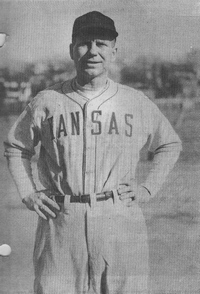
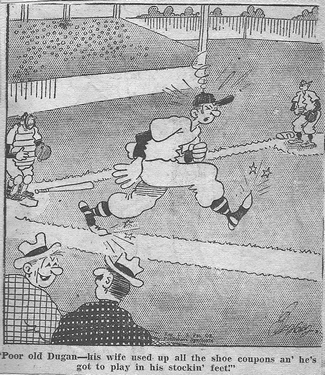 Red loved
sports, although he said his older brother Clyde was always better than he was.
He played semi-pro ball in Goff, Kansas, at the age of 16 in 1929. Before he
entered college at the University of Kansas in 1937, the Holton High School
athlete tried out for the New York Yankees. The Yankees were interested in the
youngster for their Kansas City Blues farm team, but he pitched a
thirteen-inning game for the try out and threw his arm out. Since he did not
sign a contract, he was able to play college ball and went to the University of
Kansas on a football scholarship, also playing basketball and baseball. Dugan
played football and basketball in 1938, and played baseball from 1938 to 1940.
During 1939 and 1940, he also served as assistant basketball coach under Forrest
“Phog” Allen – the “Father of Basketball Coaching.
Red loved
sports, although he said his older brother Clyde was always better than he was.
He played semi-pro ball in Goff, Kansas, at the age of 16 in 1929. Before he
entered college at the University of Kansas in 1937, the Holton High School
athlete tried out for the New York Yankees. The Yankees were interested in the
youngster for their Kansas City Blues farm team, but he pitched a
thirteen-inning game for the try out and threw his arm out. Since he did not
sign a contract, he was able to play college ball and went to the University of
Kansas on a football scholarship, also playing basketball and baseball. Dugan
played football and basketball in 1938, and played baseball from 1938 to 1940.
During 1939 and 1940, he also served as assistant basketball coach under Forrest
“Phog” Allen – the “Father of Basketball Coaching.
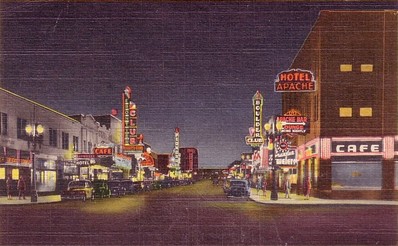
Downtown Las Vegas
in 1943

The Horned Toad,
symbol of the Las Vegas Army Gunnery School that was adopted by the
airfield's baseball team

Red Dugan (second
left) discusses pitching techniques with Hal Caskey (fourth left).
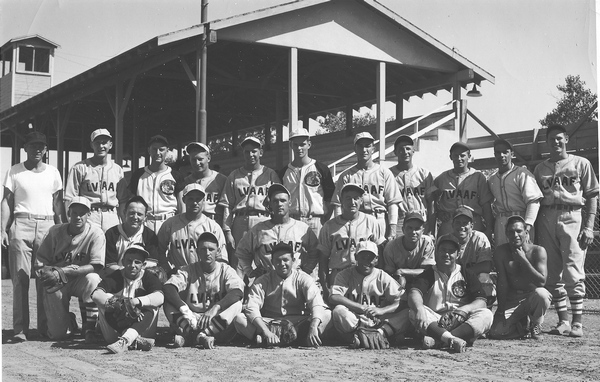
1945 Las Vegas Army
Air Field Horned Toads (Red Dugan is back row, first left).
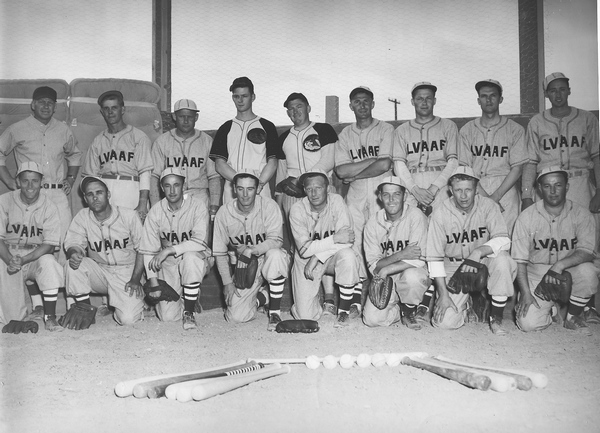
1945 Las Vegas Army
Air Field Horned Toads (Red Dugan is back row, first left).